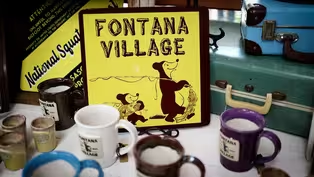
Jeansboro
Clip: Season 22 Episode 4 | 8m 59sVideo has Closed Captions
Learn how Greensboro’s role in the textile industry earned it the nickname “Jeansboro.”
Learn how Greensboro’s role in the textile industry earned it the nickname “Jeansboro.”
Problems playing video? | Closed Captioning Feedback
Problems playing video? | Closed Captioning Feedback
North Carolina Weekend is a local public television program presented by PBS NC

Jeansboro
Clip: Season 22 Episode 4 | 8m 59sVideo has Closed Captions
Learn how Greensboro’s role in the textile industry earned it the nickname “Jeansboro.”
Problems playing video? | Closed Captioning Feedback
How to Watch North Carolina Weekend
North Carolina Weekend is available to stream on pbs.org and the free PBS App, available on iPhone, Apple TV, Android TV, Android smartphones, Amazon Fire TV, Amazon Fire Tablet, Roku, Samsung Smart TV, and Vizio.
Providing Support for PBS.org
Learn Moreabout PBS online sponsorshipOur first stop takes us to Greensboro, which was once the denim capital of the world.
In fact, its denim legacy is so profound, some folks call it Jeansboro.
[sewing machine clattering] [sewing machine rattling] [suspenseful music] - History to me is one's ability to understand why and where they come from, and what its significance to the world has been.
[sewing machine rattling] Our city has now 128 consecutive years of manufacturing denim, which is unrivaled by any city in the world, making Greensboro unequivocally the Mecca of jeans.
[uplifting music] We were formerly the home of the world's largest denim mill, White Oak Cotton Mills, but also still remain the home of Cone Denim, as well as Wrangler, and its former name Blue Bell, which was the world's largest producer of work clothing.
Greensboro, or Jeansboro, is a place that you could eat, stay, and play, not only to have a good time, but also do things that are denim related.
- By the mid 1930s, more denim was produced in Greensboro than anywhere else in the world.
Right now we're standing in denim capital.
In this exhibit, we learn not just some of the facts about factories and denims and the people that were the owners, but the people who worked in these factories, and you get a sense of their full life stories.
The Cones had several factories, Print Works, Proximity, White Oak, and Revolution Mills, all producing different kinds of fabrics, denim being the primary one, but they also produced flannel and corduroy and printed fabrics.
[uplifting music] - East White Oak was one of the city's mill villages, which was created by Cone Mills Corporation.
It was the community of African American employees of the mill.
This space started as a school for the children of African American Cone Mills workers.
On the wall behind me is a picture of my grandfather, Truman A. Gant.
The building was gonna be closed.
It had already been condemned.
The city was going to have it torn down, and he went to a zoning meeting.
When they asked, "Are there any objections, any protests?"
He said, "I object.
I protest."
The community banded together, saved the site.
It still exists today.
The East White Oak Community Center is on the National Register of Historic Places.
You don't have very many places where there are one-room school houses.
You don't have very many places that can say that a legendary Civil Rights hero was from our community.
For those who are interested in seeing the impact of a small people with great strides, this is a great place to visit.
[gentle music] - Is this your first time in?
Hudson's Hill is a boutique and general store.
Everything that we carry in the store is made in USA.
We carry a raw, mostly salvaged denim.
It can only be woven on certain types of looms that aren't even manufactured anymore.
So it does take an artisanal touch and knowledge to be some of the only people that are actually consistently manufacturing American-made denim, and to be, basically, the only store in the country that carries it in the town where it's made is just such a unique thing.
We couldn't make the products that we do and embrace the history and have this concept anywhere else other than Greensboro because this is the only place that we can have a store like this and do what we do.
[uplifting music] - This store is different to our other locations.
First, proximity to corporate headquarters, this being kind of their flagship store.
We carry some collaborations and things here that you will not see anywhere else.
We also will have products in here before it goes to market, and we like to see how the community responds to it.
- Today we're sitting in the middle of what was formerly Revolution Cotton Mills, which, during its heyday, was the world's largest producer of corduroy and cotton flannel fabrics.
You can witness things like looms, spinning equipment.
Innovations in Blue was opened as an exhibit showcasing 100 years of indigo dye technology, as well as the pioneer dye master himself, Floyd Virgil Hayes.
He was an African American gentleman that could not read or write, and he standardized the indigo dye recipe for White Oak Cotton Mills by taste, and he was made the first dye master.
We have this ever-growing number of places to dive in and eat, but not only here at the mill.
In other places in Greensboro, names harken from the earliest days of Greensboro's textile history.
- Blue Denim is a place where we celebrate the food ways of the New South.
We do a lot of Cajun and Creole cuisine.
There are gonna be a few items that are gonna always be on our menu.
Our crawfish beignets, gumbo yaya, shrimp and grits, and crawfish fettuccine, those things never leave.
And the white chocolate bread pudding never leaves the menu, but all the other items come and go.
Over the front window, we have two curtains that are made from bandanas that were made at Cone Mills.
Our cushions on our benches are made from denim that was made at Cone Mills.
[upbeat music] [patrons chattering indistinctly] - With Print Works, we decided that we would like to have a restaurant that we would like to go to, that has a sort of French bistro as it foundation, but also contextualized to Greensboro, North Carolina.
You can't be more than 16 feet away from a window and every window overlooks a garden.
You feel like you're a million miles away from a city.
The original Proximity Mills was named that because of its proximity to the cotton fields and the railroads.
We got to build a hotel that was consistent with our dreams.
It became the first LEED Platinum hotel in the world.
Rock and roll.
White Oak has this saw tooth.
It was a way you make the windows facing north so you could have natural light into the mills.
In this case, we're not letting natural light in, we're letting the energy of natural light give you a warm shower.
[gentle upbeat music] - There are so many ways that the hotel shows the denim history.
Color of the walls and the lobby here, the indigo dye actually starts off being green, and then as it oxidizes, it becomes that pretty indigo blue that we're used to seeing in denim.
The hooks that are above the bench and luggage area are shaped like jean buttons.
The vinyl on the headboard and bench that you'll find in the room is the same color as the tag you would find on Wrangler jeans.
Our lobby market also features a lot of North Carolina snacks and things that are locally made here in Greensboro.
[gentle upbeat music] - We showcase our history at Grandover, which is demonstrated throughout the property.
[uplifting music] The Cone Denim Suite and the Carolina Suite are both bi-level suites, so the living area and the common area's on the first floor, but you travel upstairs to two beautiful, massive bedrooms.
[uplifting music] The days of working in the mill is not known to current generations like it had been to our grandparents, and that's a story that we want people to know.
It's one that needs to be retold and retold again.
It's the fabric of what made us the United States.
It's the fabric that made us a place that showed what ingenuity could do.
[uplifting music] - Having hotels named after denim plants and having refurbished mills that are now multi-use properties, Jeansboro statues throughout town, it just brings that to life for a new generation.
[uplifting music continues] [loom clattering] - History is not only the goal of acquiring the knowledge, but care-taking for it to pass it along.
[uplifting music continues] [sewing machine rattling] - To learn more about Greensboro's denim legacy, go to visit greensboronc.com.
Video has Closed Captions
Clip: S22 Ep4 | 5m 14s | Fontana Village, which once lodged workers who constructed Fontana Dam, is now a popular resort. (5m 14s)
Video has Closed Captions
Clip: S22 Ep4 | 7m 14s | A look at The Harvey, a 1790s building that has been transformed into a boutique hotel in New Bern. (7m 14s)
Video has Closed Captions
Preview: S22 Ep4 | 26s | Get to know the history behind some beloved destinations in NC. (26s)
Providing Support for PBS.org
Learn Moreabout PBS online sponsorshipSupport for PBS provided by:
North Carolina Weekend is a local public television program presented by PBS NC
















